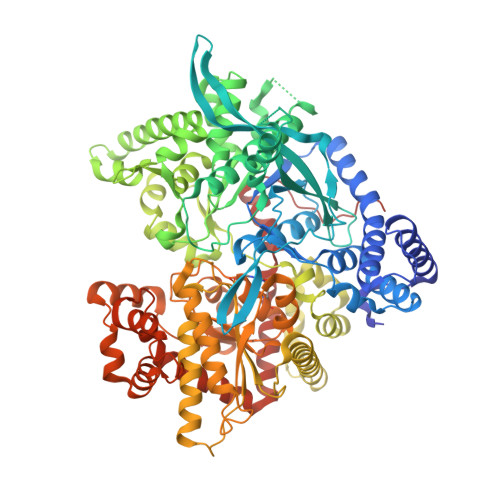3'-Axial CH(2) OH Substitution on Glucopyranose does not Increase Glycogen Phosphorylase Inhibitory Potency. QM/MM-PBSA Calculations Suggest Why.
Manta, S., Xipnitou, A., Kiritsis, C., Kantsadi, A.L., Hayes, J.M., Skamnaki, V.T., Lamprakis, C., Kontou, M., Zoumpoulakis, P., Zographos, S.E., Leonidas, D.D., Komiotis, D.(2012) Chem Biol Drug Des 79: 663-673
- PubMed: 22296957
- DOI: https://doi.org/10.1111/j.1747-0285.2012.01349.x
- Primary Citation of Related Structures:
3SYM, 3SYR - PubMed Abstract:
Glycogen phosphorylase is a molecular target for the design of potential hypoglycemic agents. Structure-based design pinpointed that the 3'-position of glucopyranose equipped with a suitable group has the potential to form interactions with enzyme's cofactor, pyridoxal 5'-phosphate (PLP), thus enhancing the inhibitory potency. Hence, we have investigated the binding of two ligands, 1-(β-d-glucopyranosyl)5-fluorouracil (GlcFU) and its 3'-CH(2) OH glucopyranose derivative. Both ligands were found to be low micromolar inhibitors with K(i) values of 7.9 and 27.1 μm, respectively. X-ray crystallography revealed that the 3'-CH(2) OH glucopyranose substituent is indeed involved in additional molecular interactions with the PLP γ-phosphate compared with GlcFU. However, it is 3.4 times less potent. To elucidate this discovery, docking followed by postdocking Quantum Mechanics/Molecular Mechanics - Poisson-Boltzmann Surface Area (QM/MM-PBSA) binding affinity calculations were performed. While the docking predictions failed to reflect the kinetic results, the QM/MM-PBSA revealed that the desolvation energy cost for binding of the 3'-CH(2) OH-substituted glucopyranose derivative out-weigh the enthalpy gains from the extra contacts formed. The benefits of performing postdocking calculations employing a more accurate solvation model and the QM/MM-PBSA methodology in lead optimization are therefore highlighted, specifically when the role of a highly polar/charged binding interface is significant.
- Department of Biochemistry and Biotechnology, University of Thessaly, 26 Ploutonos Str., Larissa, Greece.
Organizational Affiliation:


















